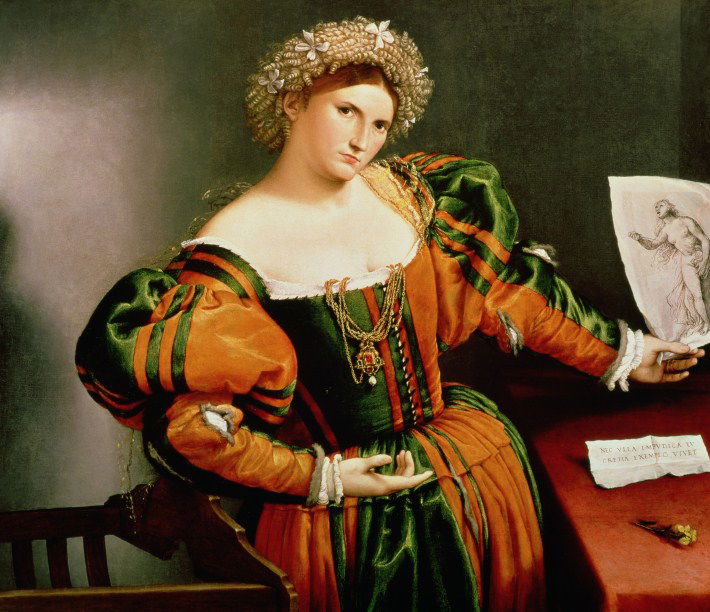 |
| A Lady with a Drawing of Lucretia, by Lorenzo Lotto, c. 1530-33. Copyright Bridgeman Art Library 2010 Check out these guns! |
.jpg) |
| Nothing says Ivanhoe like black tulle and geranium satin! |
Sophie du Pont is just 10 years old and probably more concerned with dolls and practicing needlework rather than fashion. To understand a little bit more about these years in fashion I want to focus on the work of Elisabeth McClellan, Historic Dress in America. The book was published in 1904 and is perhaps my favorite book on historic clothing. Many folks today complain about the lack of illustrations, or the overwhelming amount of information...but, those are things I enjoy about the book. I love reading her descriptions - trying to imagine the outfit she is describing, somehow I try harder to "see" it rather than just looking at an illustration. McClellan can overwhelm you with information, but many of the resources she had access to have long since vanished leaving her work as an invaluable source.
Now onto the fashion! She begins 1820 by relating that black dresses "came into favour" and the fashion world introduced two new fabrics with plume velvet and levantine satin - both used for evening dresses. Furthermore, highland tartans had experienced ups and downs in popularity for the last five years but "became a pronounced fashion in 1820, even for evening dresses". (McClellan, p.141) The newly published romance "Ivanhoe" shared title with a black tulle and geranium satin evening cap. McClellan continues to dissect the style changes of 1820 and moves from the fashionable influence of the Scots to the overwhelming use of flounces. ;)
 |
| cotton dress, France, 1818-1820 Les Arts Decoratifs Let's Count the Flounces! |
"We notice at this time frequent mention of flounces as trimming for ball dresses, but it soon became fashionable to trim everything with flounces." (McClellan, p.143)
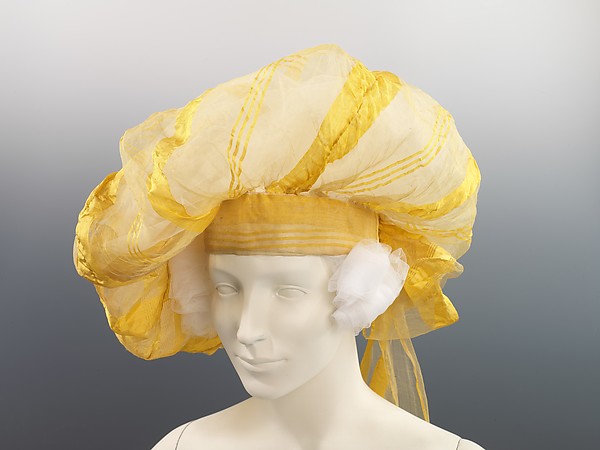 |
| ca. 1820 turban, silk, British MET Museum That's one pouffy turban! |
Young married ladies in Paris had a preference for richly embroidered turbans fastened with gold brooches and embellished with feathers of herons, marabouts, ostriches, or birds-of-paradise. Metallic gauze persisted as being fashionable in both evening hats and turbans. Transparent fluted bonnets with a wreath of ribbons trimming the crown and edged with plaited gauze were all the rage. The fashion for transparency continued in the introduction of many new fancy gauze's in 1821 designed especially for bonnets and headdresses. The meaning of names were already lost on Elisabeth McClellan when she penned her costume history at the turn of the 20th century. Marbled gauze, marabout gauze, deluge gauze, and flowered gauze tempt our imagination with their mysterious meanings. (McClellan, pg.147)
Silk dresses for evening and half dress challenged the ever-popular muslin for reign supreme. McClellan describes these silk frocks ornamented with silk quilling arranged in bias to create a "rich effect", perhaps resembling the dresses pictured below. (McClellan, pg.147) Additionally, black velvet dresses ornamented with beads were fashionable for evening parties and "white cachemire dresses, trimmed at the border with three bands of satin, are much worn at the Parisian tea parties."(McClellan, pg.154)
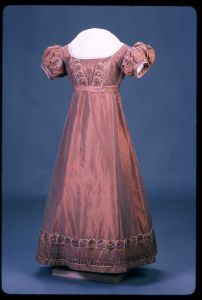 |
| ca.1820 Silk dress, American, Old Sturbridge Village |
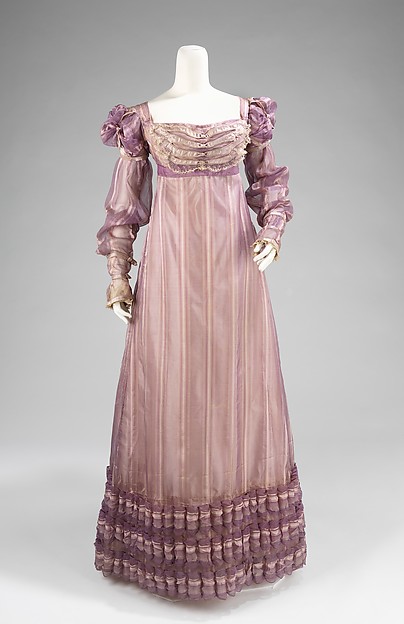 |
| 1820 silk dress, American MET Museum |
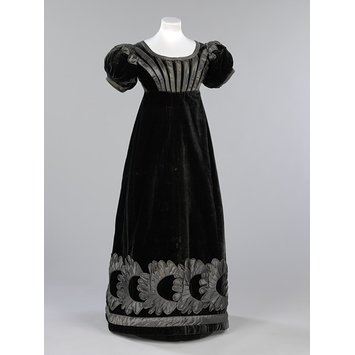 |
| 1823-1825 silk velvet dress, Scotland V&A Collection |
 |
| 1824 silk wedding dress, American MET Museum Portrait of a Lady, ca. 1820 - Andrew Mellon Collection Check out the amazing collar of her pelisse....puh-leezz girl! |
 |
| Zenaide & Charlotte Bonaparte, 1821 by Jacques-Louis David Napoleon's nieces - the eldest, Zenaide wears a black velvet dress |
Pelisses were still very much in fashion and the authoress shares a coveted ensemble of a gray levantine pelisse trimmed down the front and around the bottom with "puffings" of the same material, a satin bonnet of a marguerite color, a plain fichu of find India muslin, slippers of grey kid, a beaded reticule and lemon-colored gloves. Marguerite was likely a light pink or yellow owing to the Marguerite daisy which came in both colors. (McClellan, pg.155)
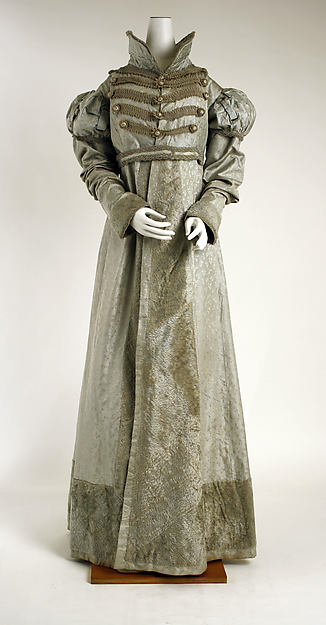 |
| ca.1820 silk pelisse, American MET Museum |
Now, from pelisses to hats we have much to learn perhaps Ms. McClellan can educate us a bit:
"The hats are somewhat smaller in the brims, though there are some hats which are bent down in the shape of bonnets: straw hats of every shape, are now becoming very general for walking; Leghorn hats have already made their appearance; the brims much narrower than formerly; they are ornamented with a narrow scarf of plaid silk, forming a circular drapery. These hats are placed on one side, and the hair that is exposed is arranged in full curls or ringlets." (McClellan, pg. 153) She goes on to advise that, "The most tasteful bonnet for walking is a curled plush silk of beautiful pink; and grey hats with flowers of the same colour, made of velvet or chenille, are in very great favour."(McClellan, pg.153)
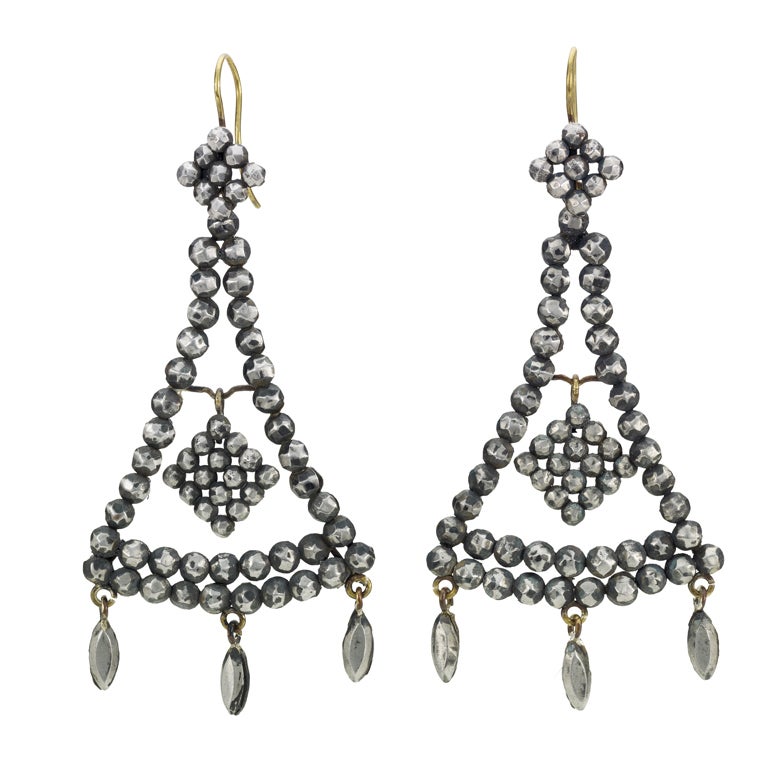 |
| Georgian Cut Steel Earrings -1820 |
Of course, the fashionable belles that you are I'm sure you are dying to know the most vogue accessories to wear with your velvet and silk frocks. First, is the parasol with the most elegant of India muslin, "embroidered with a beautiful border in feather stitch, instead of fringe; the edge is finished with broad Mechlin lace, about four inches in breadth...lined with azure blue, shot with white; the stick and handle are of polished steel, the thick part is beautifully wrought and the handle is formed like the leaf of the acanthus."(McClellan, pg.152)
The mode in jewelry is polished steel. "A brooch of polished steel confines the gown to the bust, and another is placed in the back between the shoulders", a look most elegant in the following description.
"A very pretty woman appeared in public last week and all her numerous ornaments were of polished steel: her dress was a marshmallow-blossom colour, which admirably set off the superb brooches she wore in front of her bust, and at her back." (McClellan, pg.152)
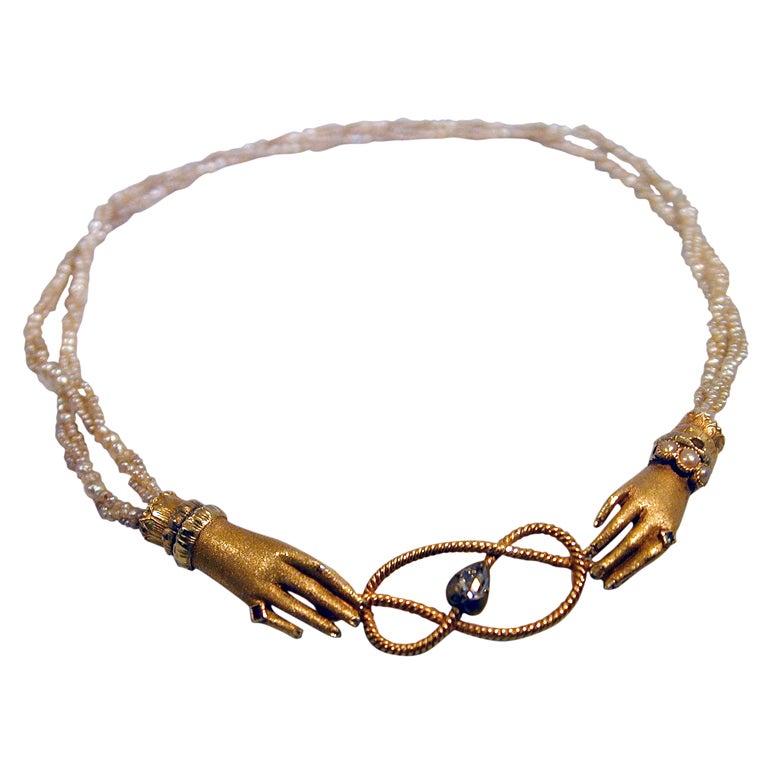 |
| 1826 hand motif necklace seed pearls, gold, emerald, diamond and ruby |
Whew! It's not easy being fashionable in the 1820's. Hope you learned a little bit and are inspired to read much further into Elisabeth McClellan's, Historic Dress in America. Maybe on your next 1820's dress project you can add a style element or two featured here. Now, if someone could just make an inexpensive reproduction of that sweet hand motif necklace...well, that would be...sweet! :)

LOVE all the visuals you find! (oh, and I guess your text is okay, too ) ;)
ReplyDeleteThanks Julie...I think! :D It's getting more difficult with Pinterest around to find good
Deleteimages that you can actually figure out where they originated. Btw - if you click on
the jewelry images it'll take you to an amazing Georgian jewelry auction site. :)
Your passion and enthusiasm for this decade of fashion, and historical fashion in general is inspiring. I truly enjoyed this post and wish I could purchase that black Scottish frock for my girls!! : ) Thank you for the interesting information and I particularly appreciate the links, as much of this is new information for me. I am going to share your blog with some friends who I know will love it. Favorite quote " it's sort of like the Little Bo Peep look...on acid" Looking forward to the next installation!!
ReplyDeleteSusan, you and all your brood are just the best people. You and Mark need to write how-to books to life because you totally get it. I know this isn't really your favorite subject but I absolutely appreciate you taking the time to read the blog and leave wonderful comments. Thank-you!
DeleteOk, must get out my McClellan and dust it off!
ReplyDeleteMcClellan's work is definitely an oldie but goodie!
Delete